If you want to create ungated interactive product demos for marketing & top-of-funnel use cases, Navattic is great. I actively recommend it.
If you find yourself here though, it likely isn't a fit for some reason. Maybe:
- You want something that can handle live demos for sales too
- You prefer screenshot capture to HTML capture
- You're very early stage & the price is inaccessible
Whatever the reason, here's 8 interactive product demo tools that might make a suitable alternative.
Here are the 8 best alternatives to Navattic
- Supademo
- Walnut
- Tourial
- Storylane
- Arcade
- Lancey
- Demoboost
- Reprise
Let's take a look at the differences.
1. Supademo
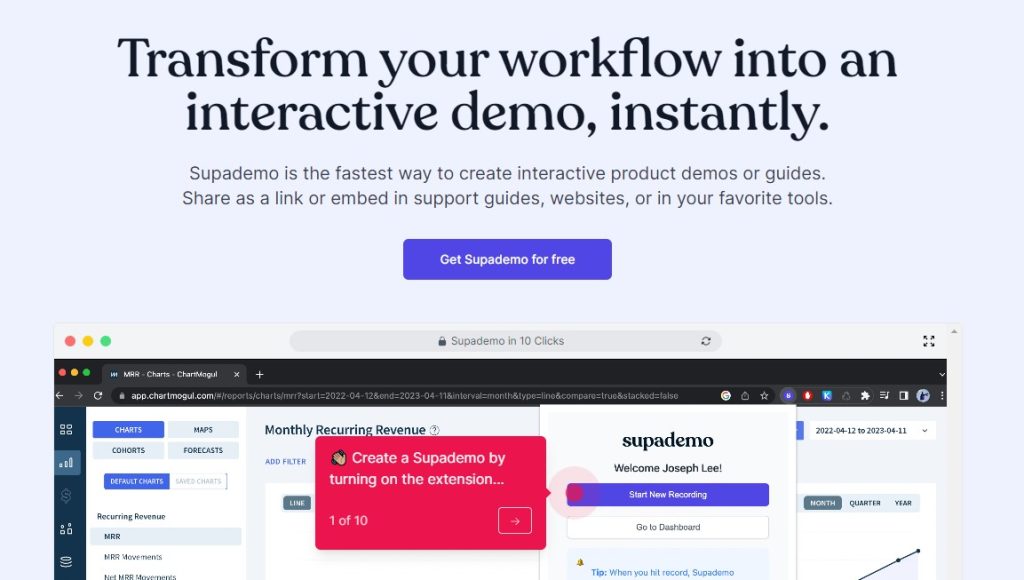
Best suited for: entry-level solution for product walkthrough tours
Free trial: Free plan for up to 5 demos.
Starting price: Free, then $24/month for 5 user seats & unlimited demos.
Key features
Supademo offers a similar use case to Navattic (making interactive product demos), with a couple of key differences:
- t's a much cheaper solution, with a free version & monthly options
- It uses screenshot capture instead of HTML capture
- It comes without some of the bells & whistles (think integrations, some data, strategic support)
If you're looking for something simpler on a lower budget to implement your first interactive demos, Supademo is probably a good bet.
It uses a Chrome extension to capture screenshots & videos, and time-to-launch is fast.

One of the key drawbacks to using screenshots instead of HTML capture (like Navattic) is that you can't easily edit screens. With code, you can click into a text area to change it, adjust charts, blur stuff out etc.
Supademo solved that (in part — not entirely) with a recent update that enables annotations & editing, which is available on the higher pricing tier.

Supademo vs Navattic
- Supademo has a much lower entry price & monthly plans
- Navattic has more integrations (Segment, Zapier, Salesforce, HubSpot)
- Supademo uses screenshot capture, while Navattic uses HTML
- Navattic have more strategic support available from more experienced CSMs
Pricing
Supademo has a free version for 5 demos, and paid plans start from $24/month for 5 users & unlimited demos. Custom pricing is available for more seats and additional features.
2. Walnut

Best suited for: a complete replacement for Reprise with a lower cost & easier usability
Free trial: No. Request a demo here.
Starting price: Unknown.
Key features
While Navattic focuses more on top-of-funnel, Walnut, is more similar to Demoboost in covering multiple use cases, primarily focusing on sales & pre-sales.
Walnut captures your product's front-end using a Chrome extension, then enables either no-code editing, or HTML editing.
One unique feature of Walnut is that you can enable prospects to leave comments & questions directly inside the interactive demo, just like collaborating in a Google Doc or a Figma file — which makes for a more interactive sales experience.

Walnut is also strong in internal team collaboration, with all the basics covered: access/permissions, various sharing settings, and ways to tag/group demos internally.
Plus, you can create demo templates & save into a shared library. With those templates, anyone in the team can then quickly find a template, understand what it's used for, and reuse it for their use case.

Walnut offers analytics features to help you check who has used your demos, for how long, their completion rates & more.
It has integrations with Salesforce & Hubspot, but lacks a couple of others (e.g. Google Analytics, Zapier, Segment).
See also: Walnut alternatives.
Walnut vs Navattic
- Navattic is better for marketing, Walnut is better for sales (but also caters to marketing)
- Walnut's pricing has unlimited demos & demo views, but not unlimited seats (Navattic's does)
- Navattic has some integrations that Walnut is missing (e.g. Segment, Zapier, Google Analytics)
- Users typically report that Navattic is easier to start with & use
- Walnut has better collaboration features, e.g. Google Docs style comments in demos
See also: Walnut vs Navattic full comparison.
Pricing
Walnut determines its pricing based on user seats. Every plan comes with unlimited demos created and unlimited demo views.
3. Tourial

Best suited for: creating interactive demos for marketing use cases with screenshots/videos
Free trial: No, request a demo here.
Starting price: $790/month (paid annually). See pricing.
Key features
Like Navattic & Supademo, Tourial focuses on the product walkthrough use cases. It's more advanced than Supademo in terms of features & integrations, and closer to Navattic in terms of maturity.
First: Navattic uses HTML & CSS capture, while Tourial uses screenshots & video capture. The latter method might be more suitable for handling:
- Lots of complex workflows → you can add video captures to save on click fatigue
- Mobile apps & mobile traffic (it's much easier to mobile optimize)
- Lots of JavaScript functionality → HTML capture will miss actions e.g. drag n drop
On the other hand, HTML & CSS has the advantage of being able to easily click & change text, data, edit the UI to customize the demo screens exactly how you'd like them.
Unlike Reprise, Tourial is not built to handle sandbox environments & live demo overlays — like Navattic, they focus on the product walkthrough use case.
Lastly, a notable unique feature is their TourPlayer, which lets you create a ‘playlist' of demos all in one place easily. Take a look at their own demo center for an example.

Tourial vs Navattic
See also: Navattic vs. Tourial full comparison.
- Tourial uses screenshot capture, while Navattic uses HTML capture
- Pricing is similar, but Navattic's entry price is lower. Both include unlimited seats
- Navattic has Segment & Zapier integrations which Tourial doesn't
- Tourial has Chili Piper & Calendly integrations, which Navattic doesn't
- Tourial's TourPlayer feature is unique
Pricing
Tourial offers 1 simple base platform package that comes with unlimited demos, user seats, demo views, integrations, forms, support, and TourPlayers. View full plans page here.
Their Startup package is available for companies with < 50 employees and includes all features, onboarding, and digital support.
4. Storylane

Best suited for: a scalable platform to start small & grow into premium features
Free trial: Limited free plan available (1 demo). Request a demo here or look at their product tour.
Starting price: Paid plans from $40/month for 1 user seat (paid annually).
Key features
Storylane is a pretty flexible platform. You can get started at a lower price than Navattic, with limited users/features & screenshot capture. Then, grow into a larger plan later — with HTML capture, lead forms, and other premium features available on higher pricing plans.
Realistic entry price for a comparable service (HTML capture + advanced features) is similar.
For marketing, feature sets are quite similar too. Here are two notable things Storylane has, which Navattic doesn't:
First, a navigation feature, which lets users jump back & forth through the demo.
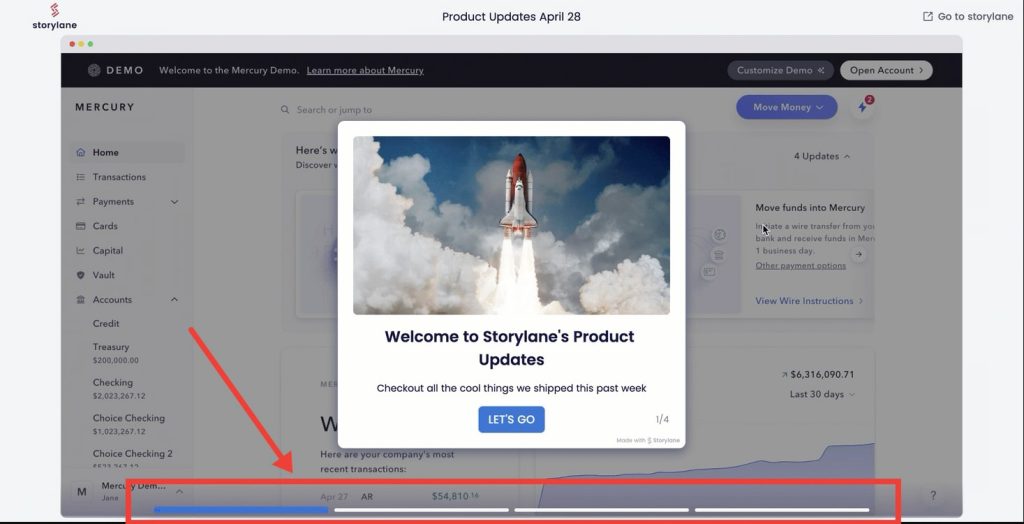
Second, the possibility of accepting text inputs into a HTML demo. For example, you can prompt a user to type ‘cards' into a search field, which would lead to a specified screen.
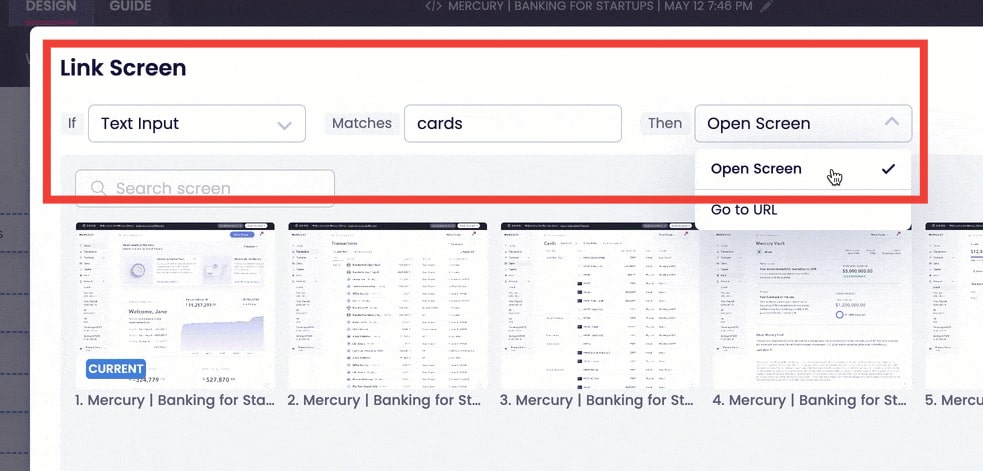
Storylane vs Navattic
- Storylane enables adding videos to demos, Navattic doesn't
- Storylane caters for both sales & marketing, while Navattic focuses on marketing
- Navattic includes unlimited user seats on every plan, Storylane does not
- Storylane has an API available, Navattic does not
- Both platforms have checklist features to tailor journeys & CTAs
- Storylane has extra integrations (e.g. Clearbit)
See also: Navattic vs Storylane full comparison.
Pricing
Storylane has a limited free plan, and paid plans start from $40/month (paid annually) for 1 seat. Additional seats cost extra. A startup discount is available; contact their team.
Compared to Navattic, the starting price for a comparable service (HTML capture, advanced features) is quite similar. $500 per month. The big differences are that: Navattic has unlimited seats, whereas Storylane bills for every extra seat. And Storylane has features for live sales demos.
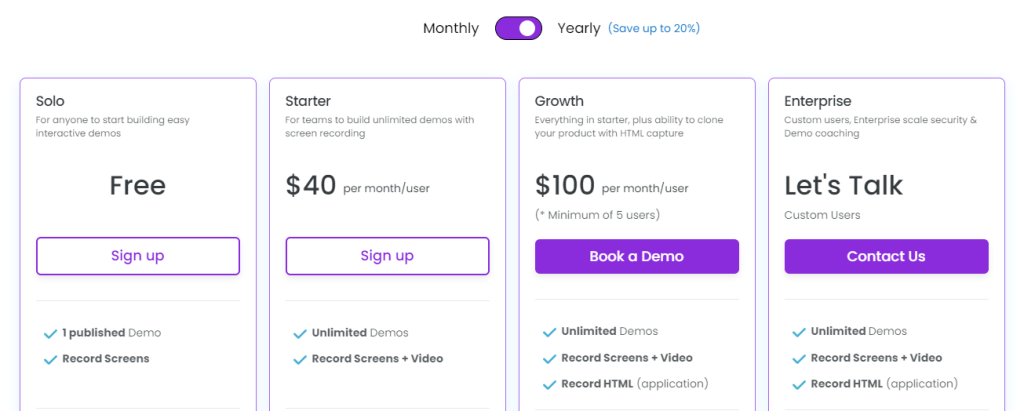
5. Arcade

Best suited for: marketing teams in need of marketing demos that can easily be embedded onto websites, blogs, and social media.
Free trial: offers a freemium model. Sign up here.
Starting price: Free. Paid plans from $38 per month.
Key features
Arcade is quite similar to Tourial, in that it uses screenshots/videos (while Navattic uses HTML capture), but has a more mature set of features than newer tools like Supademo.
A couple of notable differentiators:
Arcade lets you integrate video, like other tools, but it also supports audio. For example, to explain a feature, or just build trust by showing your face.

The higher pricing tier includes built-in video editing features (e.g. speed up, trim) to streamline your demo creation workflow, white labeling, and team collaboration features.
Like Storylane, Arcade lets you start small and grow into more features.
Arcade vs Navattic
- Arcade uses screenshots & video, Navattic uses HTML capture
- Arcade has monthly plans & lower entry pricing
- Navattic offers unlimited seats, Arcade bills per seat
- Navattic has more integrations for CRMs & data/automation
Pricing
Arcade uses a freemium model, with the free version letting you create up to three publicly shared demos. Paid plans start from $32/user/month, and some features are locked into higher pricing tiers.
6. Lancey.io

Best suited for: simpler tool with ease of use, fast time-to-value, and lower entry price (without some bells & whistles). monthly plans available.
Free trial: Yes, 14 days. Sign up here.
Starting price: Free. Paid plans from $36month (monthly) or $29/month (billed annually) per seat.
Key features
I'd put Lancey in the same bucket as Supademo. A newer tool in this category, not quite as mature in terms of features & integrations as Navattic, but with recent seed funding and progressing fast. They offer monthly plans where Navattic doesn't, and an accessible entry price for smaller teams.
You can see an interactive demo made with Lancey on their product page.

Some things you might want to know:
- Lancey has a very fast time-to-value, including a self-serve offering & free trial
- There are features available for personalization, and AI text-to-speech for audio overlay — but these aren't on the entry pricing plan
- As an earlier stage product, some features & integrations might be missing. For example, Segment & Zapier is missing
- There's no ‘choose your own journey' features like Navattic's branching & checklists
Overall though, it's a clean & accessible product with all the core offerings that you may want to consider.
Lancey vs Navattic
- Lancey has a lower entry price & monthly plans available
- Navattic has unlimited seats, Lancey bills per seat
- Lancey uses screenshots & video, Navattic uses HTML capture
- Navattic has more integrations (Segment, Zapier)
- Navattic has features for tailoring demo journeys
Pricing
You can publish 1 demo for free. Lancey also has monthly plans available, unlike Navattic.
Paid plans start from $29 per month per seat.
7. Demoboost

Best suited for: a single platform to cover marketing, sales, and success demo use cases
Free trial: No. Request a demo here.
Starting price: Unknown.
Key features
Demoboost works for marketing product walkthroughs, but fundamentally, it's built for sales teams & live sales calls. It lets you build a library of demo templates that SDRs & AEs can quickly personalize for their prospects.
It uses HTML & CSS for capturing the product, but lets you integrate any type of multimedia into the demo.
Here's some notable features:
- Internal feedback: add comments Google Docs style to collab on demo creation
- Multi-media: incorporate images/videos alongside your product UI during product tours
- Speaker notes: AEs can add notes that wouldn't be visible to prosects during calls
- Built-in A/B testing for CTAs & messaging
Regarding security features, Demoboost is GDPR compliant, ISO certified, and has SSO & role-based access.
Demoboost's customer success team are offering unlimited support in helping to build demos, even before you sign up as a customer. If you're looking to create a demo library for a sales team, it's worth speaking to their team.
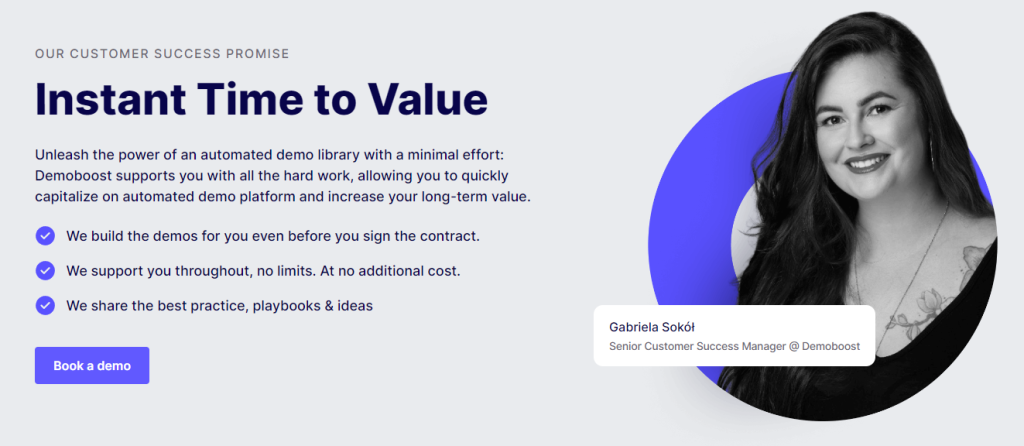
Demoboost vs Navattic
- Demoboost is sales-first, while Navattic is marketing-first in terms of focus
- Demoboost enables use of images/video alongside HTML capture; Navattic doesn't
- Navattic's entry price is lower
- Security features are comparable
Pricing
Demoboost pricing isn't publicly available. Contact their team for a demo.
8. Reprise

Best suited for: 300+ size teams with comprehensive needs for both marketing & sales demos
Free trial: unknown. Request a demo.
Starting price: unknown.
Key features
Reprise offers a versatile demo creation platform that you to build three types of demos: product walkthroughs (like Navattic), plus live demo overlays for sales, and complete explorable sandbox environments to give to prospects.
This versatility makes Reprise particularly useful for organizations that need a unified platform for their sales and marketing teams, and have the budget for a more expensive platform.
They're built for enterprise, and focus on team sizes of 300+.
Reprise also has enterprise-grade security, including being one of the earliest platforms in this space to get SOC 2 type 2 certified, and having a dedicated in-house Direct of Information Security.
You can see an example of an interactive demo made with Reprise here.
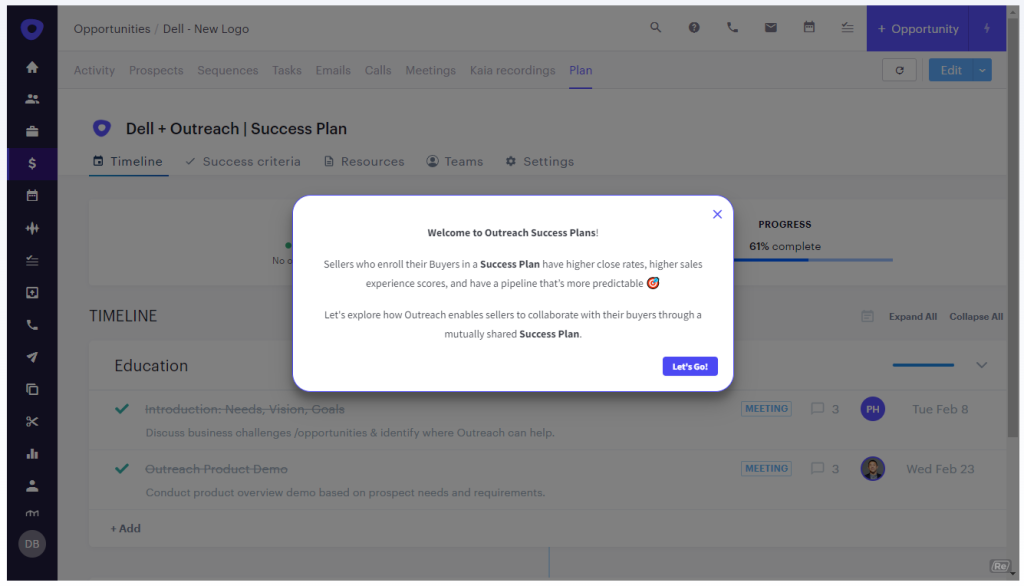
The platform also includes native integrations with analytics tools such as Google Analytics, Salesforce CRM, or Hubspot Analytics.
Typically, Reprise customers would report a longer time-to-value to get set up initially compared to similar platforms. Once everything is in place, though, it gets much faster to replicate your demo templates (e.g. an AE can prepare for a sales call quickly).
Reprise vs Navattic
- Reprise pricing is typically higher
- Neither platform offers a monthly option
- Reprise focuses on serving sales/presales/marketing, while Navattic serves marketing
- Navattic is naturally faster to implement, because it offers fewer features
- Reprise caters for live demos, Navattic does not
See also: Reprise vs Navattic full comparison.
Pricing
Reprise pricing isn't publicly available; get a tailored quote by requesting a demo. Unlike Navattic, Reprise does not include unlimited seats & demos in plans.
Final thoughts on Navattic competitors
If you're looking at Navattic alternatives for a marketing use case, I'd consider looking at:
- Mature tools (comparable costs): Storylane, Tourial, Arcade
- Newer tools (lower costs): Supademo, Lancey
Or if you need to cover sales demos too, look at Demoboost, Walnut, or Reprise.
